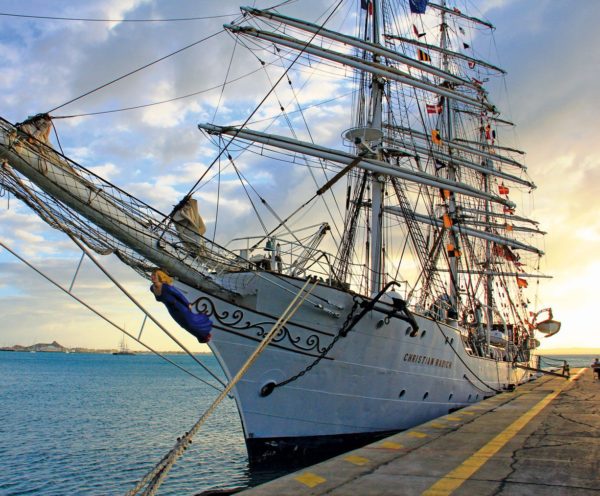
French St. Martin is fast becoming the sail training/tall ship capital of the Caribbean. The latest ship to grace the commercial port of Marigot was the beautiful three-masted square rigger Christian Radich. I visited the ship before she left to continue ocean wandering with her eclectic crew of professionals and trainees.
Built in Norway over 80 years ago, Christian Radich is resplendent thanks to constant maintenance involving hours of hard work by the crew. Sailing aboard is not a pleasure cruise but a voyage of discovery, discovery about oneself and one’s ability to handle weeks amongst the raw elements of wind and waves on a powerful vessel that mixes life in the present with that of the past. Scanning the lofty rig, it’s hard not to be caught in the romance of it all but how that reconciles with reefing topsails on a dark and windswept night can only be known by those who have experienced it.

Captain Fridtjof Jungeling is a seaman’s seaman, and to someone who grew up reading tales of Cape Horners and looking at photos of the shellbacks who manned them, he looked too young to command a sailing ship. He chuckled when I put this to him and described a little of what it is like to command the Christian Raditch and why he chose to skipper a sailing hip over a freighter or cruise ship.
“I like the diversity with the trainees we take on board, and I like the sailing. I’m a sailor and we sail all year round, which makes it interesting.”

Captain Jungeling says at some level he can relate to the Cape Horn ships of old. “We have no auto pilot, we are driven by the wind and it takes teamwork to make her sail. Everything is manually powered, so yes, the connection is there.”
Today, running a sailing ship requires more than just sailing skill. Stringent maritime codes of practice, certification, documentation, all must be kept up to date and it’s no mean feat to keep a commercial sailing ship compliant. Finance is always an issue.

Legions of volunteers support sailing foundations around the world. In St. Martin, that job is tackled by the Caribbean Sail Training Association, headed by Jan Roosens and his family. The Association, with strong support from management at the port of Marigot, are credited with bringing these magnificent vessels to the islands.
Logistically, bringing sail training ships to the Caribbean, working to convince officials to wave port fees and offer free berthing (as the Marigot port authorities do) is not easy. I asked Jan Roosen why he continued to do it year after year.

“If you ask my wife, she’ll say it’s because I’m crazy,” says Roosens but the humor hides a serious mission and that’s to get young people onto these ships as trainees, something that can change their lives. In the past the non-profit association have paid to fly youngsters as far as Norway to take part in sail training, and the week I was onboard the Christian Radich, two trainees from St. Martin were joining a ship in Guadeloupe.

The work of CST to encourage ports to wave their high fees has lead more sail training ships than ever visiting the region each year, which means more opportunities for local youngsters to join their training schemes. “We have over 70 sail training ships affiliated with CST,” said Roosens. He added, “Even some of the large Russian vessels that have never been here, but will visit one day, are involved.”
For more information about CST or to make a tax-free donation, visit: caribbeansailtraining.com





